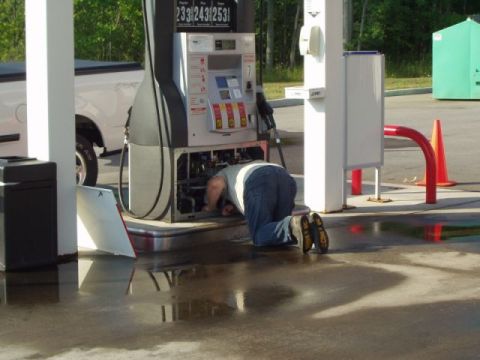You don’t have to be a non-Catholic to hate Notre Dame; specifically, its football program. The most smug, unctuous, detestable team in all of sports. Fans of the Montreal Canadiens, New York Yankees, Dallas Cowboys and Duke basketball combined can’t touch the endless sanctimony and tales of past glory spouted by Notre Dame alumni. 90 years ago Knute Rockne figured out that you could use the forward pass to beat Army, and ever since then anyone even remotely associated with the school has lived vicariously through its exploits. “Play like a champion”, as if the other >100 teams in major college football make it a point of playing like also-rans.
“We’re so special, joining a conference is beneath us. We get our very own major broadcast TV network. We have the most maddening fight song in all of college football.” Notre Dame hasn’t had an objectively good season since beating Texas A&M in the Cotton Bowl, 19 years and 6 coaches ago, but still, wake up the damn echoes. This is a school that refused to accept bowl invitations until 1969, because what about those precious student-athletes and their economics tutorials? Oh, and did you know that Notre Dame has won more national titles and had more All-Americans than any other school? Spend 3 seconds in the presence of an alumnus and you will. Furthermore, there’s a reason
(Can’t finish paragraph because that stupid song refuses to exit your head once it’s in there. SEND THE VOLLEY/CHEER ON HIGH/SHAKE DOWN THE THUNDER FROM THE SKY)
The worst part about Notre Dame? They’ve left us no choice but to cheer for Alabama and that vertically substandard hypocrite coach of theirs tonight. (Sigh) Roll Tide, and damn you all to hell.
Welcome to another Carnival of Wealth, the only personal finance blog carnival that isn’t just a cut-and-pasted laundry list of submitted articles presented without comment, creativity, editing, or standards. If you enjoy “reading” that kind of junk instead, here’s a sample (with a devilishly clever pun in the blog’s title, no less.) If you prefer something good, keep reading. Without further lament, here’s this week’s extravaganza:
Okay, here’s an example of the kind of boring and uninspired post that serves as comedy fodder if nothing else. From Christopher at This, That and the MBA,
The old saying goes that debt has its way of creeping up on us without us really even knowing it and this post will be about how to manage debt. Now a days we are so quick to pull out our credit card or debit card to make a purchase. To manage debt we need to really look close at what we are spending our money on and really track it.
Christopher allegedly has an advanced degree, and definitely has a flair for the obvious. Did you know that to manage debt, you have to look at what you’re spending money on? How did we never mention that on Control Your Cash before? Sorry about the negligence. Bonus: This post includes a 3-paragraph section without a comma, which is not easy to do. Christopher also wants you to start an emergency fund, the first and most inane tool in the personal finance blogger starter kit. We can’t wait to see more derivative posts from Christopher in the coming weeks.
Ooh, another CoW rookie. This one’s a guest post from a “blog and marketing manager” at a bankruptcy site. She writes at Call Me What You Want, Even Cheap (and we thought Control Your Cash was too long a name for a website.) This post is about what to do after you’ve declared bankruptcy.
First, if you’ve declared bankruptcy, why are you reading our site? If this is your first time here, trust us, you’re not going to like it and it’s only going to get worse. Second, the post in question offers the kind of advice that we can’t help but goof on. It’s in our blood:
Take this opportunity to develop healthy financial habits, like spending less than you earn.
Coming up with a budget for your money can help you stick to your financial goals.
Strong saving habits can help you deal with unanticipated expenses.
Eat every day. This involves putting food in your mouth, chewing it, and then swallowing it. This will help you stay alive.
Pay [your credit card bill] in full each and every month. That way, you will be building your credit and showing that you are financially responsible at the same time.
Only one of those was fake, and it doesn’t matter which. Good Lord, would it kill you people to demonstrate just a little originality? We don’t ask for much. (Maybe that’s the problem.)
We’re showcasing home improvement projects now? Oh, why not…they’re a step up from what we’ve given you so far today. From Planting our Pennies, how to replace your outmoded fluorescent bulbs with rope lights. Now, every day in your kitchen can be Christmas.
Sometimes we try to save the best posts for the end. If we do that this week, no one will read to the end. So here comes Andrew at 101 Centavos to save the day. Again. He reminds us that while many consumer goods (computers, perishable grocery items) have dropped dramatically in price over the decades, others (health care, education) have gone in the other direction. But don’t read the comments, they’re mostly pseudo-political confirmation of the commenters’ own opinions.
PKamp3 at DQYDJ.net is another consistently magical submitter. This week he analyzes the “fiscal cliff” deal that the politicians you elected (yes, you, if you’re American) passed last week. They continue to kick the can down the road, and continue to think that an increase in spending that falls short of an arbitrarily set benchmark is somehow a decrease in spending. Americans don’t hate big government after all. Well, only when it’s contrasted with colossal government.
The “American Taxpayer Relief Act” is a triumph of naming over policy, unless raising long-term capital gains rates and increasing the highest marginal rate somehow count as relieving American taxpayers. Michael at Kitces.com machetes his way through the nonsense and explains what Congress’s latest public relations project means to you.
A machine shop in your garage? The process is called 3-D printing, and according to Darwin’s Money, it’s going to revolutionize society like nothing since the Segway. But don’t let the limiting word “printing” mislead you. Basically you create a blueprint on your computer, press a button, and an attached fabricator molds plastic, resin, or even metal into whatever it is you want to build. Darwin found a 3-D printing stock that’s quadrupled in value over the past year, and he’s not a man who invests haphazardly.
No clue where to start dividend investing? Dividend Growth Investor has you covered, with a primer for the neophyte.
Keep in mind, “dividend investing” as a concept is unnecessarily restrictive. The object of investing is to secure returns. Their form (capital appreciation, dividend payment, etc., all calculated after taxes) shouldn’t matter. But dividends do imply a level of stability in a company’s finances. A penny stock with a “potential for appreciation” (they said sarcastically) doesn’t have the wherewithal to give cash payments to its investors. Coca-Cola and IBM do. Oh, speaking of Coke:
The Coca-Cola Company (KO) is a beverage company, which owns or licenses and markets more than 500 nonalcoholic beverage brands, primarily sparkling beverages but also a variety of still beverages, such as waters, enhanced waters, juices and juice drinks, ready-to-drink teas and coffees, and energy and sports drinks.
Where would we be without Dividend Growth Investor’s handy capsules of what these giant multinationals do?
All life insurance is pretty much the same, right? Odysseas Papadimitriou at Wallet Blog says whether the answer’s yes or no, you can’t comparison shop for life insurance. Why not? Because you’d have to take a separate physical exam every time you apply, and by the time you got your second set of test results back, the first company’s offer might have changed. Odysseas suggests an obvious way around this, one which the industry might adopt in a few centuries.
Hey, fat people who bought gym memberships last week! John Kiernan at Card Hub explains the psychological reasons why you did so, and why you’ll be just as fat come December 31. Also, on behalf of fit people everywhere, thanks for subsidizing our gym memberships. (kisses)
(Just kidding. Of course we wouldn’t kiss you. You’re fat!)
And we’re done. Check us out on Investopedia. Come back tomorrow for new stuff. And buy our book.




